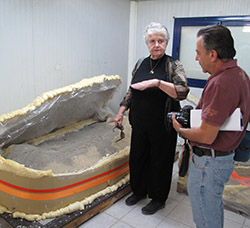Wiener Laboratory Assists with Analyzing Archaic-Period Cemetery at Phaleron

A leader in archaeological scientific research, the Malcolm H. Wiener Laboratory was recently granted permission to study the cemetery at Phaleron (the old port of Athens). The cemetery is being excavated by Dr. Stella Chrysoulaki, Ephor of Piraeus and Western Attica, and is one of the most significant necropoleis in Attica during the Archaic Period. It was used for almost three centuries, from the late 8th to the early 5th century B.C. To date, over 1,500 burials have been recovered, including nearly 400 infant and child inhumations in jars. A team of top bioarchaeologists representing the Wiener Lab and the American School – led by Prof. Jane Buikstra of Arizona State University (a Trustee of the School and a member of the American Academy of Sciences) in collaboration with Dawnie Steadman, Director of the Forensics Laboratory of the University of Tennessee – will undertake managing the study and scientific analysis of the skeletal remains. The scope and range of the burials are of unparalleled importance for the study of ancient Athens and its port of Phaleron in the Archaic Period. The potential that these burials provide for increasing our understanding of ancient Greek society is significant. Questions concerning ancient diet and disease, as well as social and political processes--such as the death penalty, political reforms, and legislation-- can potentially be answered. These answers could then lead to comparative studies that would eventually have global impact.